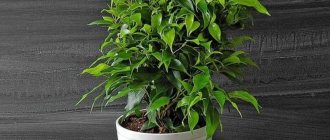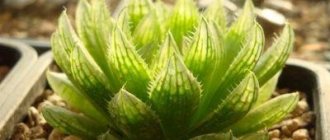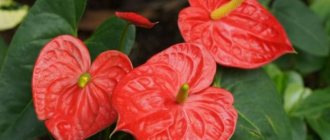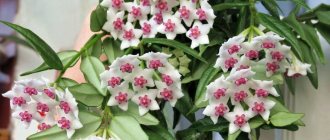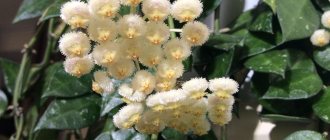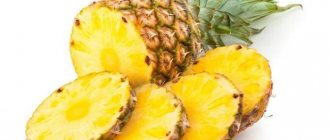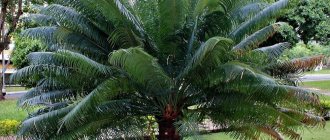Amateur gardeners can often see an interesting flower on their windowsill, something between an aloe and a cactus. This is a small, fleshy, sometimes brightly and strangely colored plant - Haworthia, an alien and guest in our latitudes. The name, which sounds so unusual, was given to the plant in honor of E.H. Haworth, a renowned biologist and researcher with a special interest in succulents.
The fleshy leaves vary so much from species to species that you don’t always recognize the plant right away. And yet each species has its own charm. The diversity and metamorphoses of the flower are very attractive, I want to know more about it.
Description
Haworthia belongs to the Asphodelaceae family, subfamily Asphodelaceae. These are monocotyledonous plants capable of flowering, belonging to the order Asparagales.
They are succulents: squat, medium-sized plants with fleshy, succulent leaves collected in a rosette. The leaves are quite intricately structured, due to white tubercles or colorless transparent areas of “windows”.
There are stem species, but their stems are very short, they are almost invisible due to the thick leaves closely arranged in a circle.
The plant blooms, as a rule, very inconspicuously, with white or indistinct greenish small flowers.
Haworthia came to us from South Africa. It has several of the same unusual names (Gavortia, Gavortia), and due to the similarity of some species to the bush, the scarlet plant is often called “dwarf scarlet.”
Biologists divide the Haworthia species into three subspecies, but the famous flower expert Valery Zlotin believes that it is more correct to distinguish five groups:
1. “Aloe-like”, which includes such common species in our country as:
- chloracantha,
- cooperi,
- limifolia,
- fasciata
- tesselata,
and also much rarer ones:
- koelmaniorum,
- pumila,
- marumiana and others.
2. “Columnar” - very popular among us H. reinwardtii, quite widely known H. armstrongii, H. coarctata, H. viscosa, as well as H. glauca and the very rare H. nigra. These species have a low stem tightly wrapped in a spiral with fleshy leaves.
3. “Flat” - exceptionally beautiful plants with flat-cut (“blunted”) leaves, usually having transparent windows. In nature, these plants are often completely submerged in the soil, with only flat areas of leaves coming to the surface. The most common species in our collections is H. truncata, a miniature masterpiece of nature. This plant has the shape not of a rosette, but of a fan, or an open book. You can also find H. retusa. However, many beautiful species are almost unknown in our country, such as:
- bayeri,
- comptoniana,
- emelyae,
- magnifica,
- maughanii,
- mirabilis,
- mutica,
- pygmea,
- springbokvlakensis and others.
4. “Lacy” - with cilia along the edges of the leaves, giving the plants a lacy appearance. This group includes H. arachnoidea with many varieties, H. bolusii, H. decipiens, H. lockwoodii, H. xiphiophylla and several others. Unfortunately, these wonderful species are practically never found here.
5. The last group is the “herbaceous” haworthia, which includes H. blackburniae, H. longiana and H. Wittebergensis. The leaves are long and thin. For example, H. blackburniae leaves, with a diameter of 3-5 mm, reach a length of about 40 cm.
Classification, family and homeland of the plant
Cooper's Haworthia (Haworthia cooperi) is a species of the genus Haworthia of the Asphodelaceae family. Originally from South Africa, it was discovered by Cooper in 1809. It has a large number of varieties, each of which has its own characteristics.
Popular types
The most popular types of haworthias have long been decorating window sills of flower growers. Thanks to their miniature size, they can be grown in city apartments without thinking about the lack of space, and if you don’t spare time, you won’t be able to take your eyes off the variety of colors in the collection.
Haworthia navicularis
Haworthia navicularis
Haworthia cymbiformis has conquered the world thanks to its remarkable qualities - it is beautiful, easy to care for, and reproduces very easily. Even in a small pot (no more than 7 cm in diameter), the flower quickly produces shoots and children, and the children immediately come with roots. Thanks to this feature, the plant forms rather large clumps. The leaves of the flower are light green, wide at the bottom and sharply pointed at the top. The short leaves look like a rook. The flowers are small, white in color, form an inflorescence on a short peduncle. Haworthia navicularis is often called “Haworthia for beginners.”
Haworthia pearl
Haworthia pearl
Quite a common type. It has dark green leaves up to 7 cm long, about 2.0-2.5 cm wide. The edges of the leaves are dotted with short white spines. The bush resembles a green flower on which pearls have been scattered, hence the second name – “pearl-bearing”. Pale greenish flowers on a short peduncle are not at all interesting in appearance.
Haworthia striped
Haworthia striped
It is this variety that resembles aloe, but the diameter of the clump is smaller, up to 15 cm in diameter. Growths in the form of warts dot the lower part of the leaf, but the upper part is smooth, greenish-marsh in color. It shows all its decorative qualities only in bright light; in the shade it loses its decorative effect.
Haworthia retusa
Haworthia retusa variegata
This also applies to very popular varieties. Haworthia retusa is very interesting in appearance - on a dense basis there are many small (no more than 5 cm) triangular, bent back leaves. The color of the jackets is very diverse, there are even red varieties (to brown). Due to the many translucent “windows” the plant looks interesting and attractive.
Haworthia sinuous
Haworthia sinuous
This subspecies has a stem tightly “packed” with small succulent leaves in a spiral. The light leaves with a wide base seem to be slightly folded inward, the lower part is dotted with tiny white warts, the upper part is smooth. The plant looks interesting and very beautiful.
Haworthia limifolia
Haworthia limifolia
Haworthia limifolia, or tercolifolia, is very similar to pearly, but its leaves are much longer (up to 9 cm). The shape of the leaf is strongly pointed at the ends and a not particularly pronounced pattern, which is mainly inside the curtain. This makes limifolia unusual.
Haworthia mix
Haworthia mix
Despite its separate name, Haworthia mix is not a species, but a method of planting in a container. A collection of dwarf succulents planted together in one pot looks stunning and very decorative.
Haworthia reinwardta
Haworthia reinwardta
Tightly pressed to the stem, up to 12 cm high, the leaves form a very unusual plant shape. It looks like a spike or a braided braid. Large growths form in comfortable conditions and make the flower look gorgeous. It can throw out a very long peduncle with small flowers - stars.
Haworthia attenuata
Haworthia attenuata
Forms clumps of dense rosettes. Each rosette is formed by 30-35 leaves, quite long (up to 8 cm), but not wide. Young leaves tend upward, older leaves bend. The pattern on the surface of the leaves is very interesting, which distinguishes this subspecies from others: on the upper side of the leaf there are longitudinal lines of tubercles, on the lower side there are transverse lines. It blooms with tubular greenish flowers collected in a raceme.
Haworthia limofolia
Haworthia limofolia
This subspecies has a unique pattern: all warts merge into solid lines on both sides of the leaf, the resulting pattern is mirrored.
Popular varieties of Haworthia Cooper
There are several varieties of this succulent. Let's briefly describe a few of them.
Haworthia Cooperi var truncata
The most popular variety. It is distinguished by truncated leaves, with invisible bristles on the sides.
Haworthia Cooper Truncata
The leaves are succulent, soft and smooth (almost transparent), 20 to 25 per rosette, with round tips and blue-green translucent patterns.
Haworthia Cooperi "Pilifera" (Haworthia cooperi var. pilifera)
This is a small bush that reaches up to 10 centimeters in diameter.
Photo by Haworthia Cooper "Pilifera"
The leaves are fleshy and have a pleasant green-blue tint.
Haworthia cooperi var. dielsiana
The main difference between this variety and other varietal varieties is the virtual absence of leaves.
Photo of Haworthia cooperi var. dielsiana (flickr.com)
It develops in rosettes, they are round in shape, up to 10 centimeters in diameter. There are also spikes on the sockets.
Caring for Haworthia at home
The plant is unusually unpretentious and responds very gratefully to care at home, especially competent care.
The soil
It is quite possible to use purchased soil for succulents, but the plant will thank you for a high-quality substrate compiled independently.
To do this take:
- clay-turf soil – 1/3;
- leaf soil – 1/3;
- sand - 1/3.
Mix everything well and add a component that absorbs moisture and increases the looseness and porosity of the soil (for example, brick chips).
Lighting
In nature, the plant does not like open places scorched by the sun. In our latitudes, the flower will say “thank you” for a sunny place on the western and eastern windowsill. The twilight on the north side, if it does not destroy the haworthia, will completely deprive it of its decorative value.
Temperature
Low and too high temperatures are detrimental to the plant. There is nothing better than the “golden mean” with a temperature of +23...+25°C. In winter, it is better to lower the temperature to +12...+15°C, ensuring the flower rest.
Watering
Haworthia is drought-resistant. In conditions of a cramped pot, dry air in city apartments, the plant needs to be watered (once a week) with well-settled water at room temperature. The criterion is drying of the soil. It must not be over-watered.
In winter, haworthia is watered once a month with cool water.
Trimming
Pruning is not necessary. Carry out only to give the desired decorative shape and very carefully.
Transfer
The criterion for transplanting Haworthia is the size of the pot. The plant feels best in a round container. It is better to take a shallow, wide enough, squat pot.
Transfer order:
- Place drainage at the bottom of the pot.
- Cover the drainage with soil so that it is visually clear that the plant will be placed correctly.
- Place the haworthia in the middle.
- Sprinkle the soil so that the roots are completely covered (to the top level), water and lightly compact the soil.
- If necessary, add more soil.
You must work very carefully. If the root system is damaged, the plant may become sick and even die.
Feeding
Haworthia responds well to industrial fertilizer for cacti and succulents. If you make up your own fertilizer, you need to pay attention to phosphorus and potassium. Nitrogen is not the best macronutrient for these plants. It is better to apply all types of fertilizing in the summer.
Haworthia in winter
Like all similar types of succulents, it is better not to disturb the flower in winter. The best way to provide a plant with winter rest is to move it to a cool, not very bright place and water it occasionally. Watering once a month with cool (not higher than +14°C) water will allow the haworthia to emerge from the winter state with honor and please the owner with a chic appearance until the next winter.
Flowering and dormancy
Starting in September, the temperature must be gradually lowered in order to transfer the plant to “winter mode”. From approximately October to March, temperatures should range from +15 to +18 °C. Gently reduce watering to once a month, but be sure to control the dryness of the earthen clod.
Starting in March, the temperature is gradually increased and watering is resumed. Around April or May, the succulent begins to form a flower stalk. Flowering lasts about a week, the buds are small and whitish. Experienced gardeners recommend cutting off the peduncle at the formation stage, as it weakens the plant.
Photo source: www.ohiotropics.com
Reproduction methods
Haworthia can be propagated in a number of simple ways.
Side shoots
To do this, carefully cut off a small shoot without roots, place it in a flat container with a damp substrate and provide a “greenhouse” for rooting. A similar method is reproduction by “children”. A daughter clump with small roots also takes root easily.
Leaf
Cut off the leaf and put it in a warm place for 48 – 72 hours to dry. Place the dried leaf in the sand, cover (make a “greenhouse”) for rooting. When the first roots appear, transplant the tiny haworthia into the soil.
Seeds
Surprisingly, it is quite possible to grow haworthia from seeds. For this:
- prepare special soil (for example: vermiculite, perlite, ceramis, sand, soil for succulents and dolomite flour (very little);
- place the substrate in wide and flat containers;
- press the seeds into the prepared substrate;
- cover the seeded containers with cling film;
- place the containers in a not very hot, semi-dark place;
- When seedlings appear, move the crops to bright light or provide lighting;
- if the seedlings are under artificial lighting, provide them with greenhouse conditions;
- dive carefully, after drying the soil.
general characteristics
All members of the genus are deciduous succulents, but the species can be very different in both size and appearance, and it is not for nothing that they are divided into 20 sections. Plant height varies from 3 to 30 cm. There are varieties that form a basal rosette, or with a short stem covered with tiny blades closely pressed together.
Haworthia species have adapted to natural conditions in different ways, the leaves of the crops include:
- hard, triangular, with a sharp apex, jagged edge and white or papillous outgrowths in the same color as the base color (Havortia pumila or Pearl);
- succulents, thick, with transparent "windows" at the ends, allowing photosynthesis when the plant is almost completely retracted into the ground to wait out a period of drought (Habortia obtusa or Scaphoid)
- thin, but covered with rather long white hairs that reduce evaporation and draw moisture from the air (Havortia spiderworta or Arachnoidea).
The plates can be pointed, rounded or truncated. The leaves are light green to dark green, monochromatic, with white spotted appendages. Some, such as Tesselata hawortia (Checkerboard), are covered in pale designs. Many species and varieties change color or shade depending on temperature and light intensity.
Flowering is not the strong point of this crop. Usually every few years, sometimes every year, a long arrow with small bell-shaped corollas, white with green longitudinal stripes at the end, emerges from the center of the rosette. After seed production, the rosette, depending on the species, can:
- bone;
- It will die, but several new plants will grow from the root;
- Keep evolving.
The root system depends on the species. Fans must remember:
- For stemmed succulents that grow between leaves or on a bare stem, you can use a regular or flat pot.
- Rosellata species with triangular, hard leaves covered with projections have a long root. Plants need tall, deep containers.
- Species with succulent, floss-like leaves that form windows at the ends require larger pots. They produce thick, fleshy roots that are much larger than the above-ground parts and which retract into the soil in dry weather. Photosynthesis occurs through transparent “windows” left outside.
Possible problems during cultivation
Unfortunately, despite their unpretentiousness, Haworthias can be capricious. For example:
- with excess or untimely application of fertilizers, the leaves change their natural color;
- if the temperature and humidity are too low, the leaves rot;
- at high temperatures and dry air (on a heavily heated windowsill) – the tips of the leaves dry out and curl;
- If the air is too humid, the leaves wither.
Proper care at home will allow you to enjoy the healthy appearance of this exotic and beautiful plant for a long time.
Varieties
Spider White
Spider White, literally translated as “white web,” is a rare, showy haworthia with succulent, triangular leaves. The color of the leaves ranges from pale green to vanilla-white. Reaches a height of 15 centimeters with a rosette diameter of about 20 cm.
The leaves have a distinct raised pattern, reminiscent of a silvery-white cobweb.
Variegated
The name comes from the English variegated - “multi-colored”, “variegated”, “spotted”. Attracts with its colors - yellow spots or longitudinal stripes on the leaves create a unique pattern. Variegata is a favorite of many collectors.
It produces unpredictable offspring - striped, pure yellow, pure green, or yellow-green. Children of a variegated form are less decorative; stripes or spots are less pronounced and less contrasting. There are dark green babies, close to natural Haworthia and distinguished by thin yellow stripes.
Twist or spiral
Haworthia limifolia spirale form - spiral form of haworthia limifolia.
A compact, graceful plant with leaves that grow in a spiral, wide at the base and tapering to the tips in a concave curve.
Color ranges from light green to dark green and brownish green. The leaves on both sides are covered with lighter convex transverse ribs. The edges of the leaves are fleshy and ribbed. Reaches 17-20 cm in size.
Diseases and pests
Shchitovka
It feeds on juice by piercing leaves and stems. A large number of pests can completely destroy the plant.
Mealybug
Mealybugs (hairy lice) are named for their white, cotton-like secretions. When this pest appears, the flower suffers and growth is completely retarded.
To control pests, it is necessary to treat the plant with insecticides. The best insecticides are “Aktara”, “Aktellik”, “Mospilan”. The treatment is carried out according to the instructions, twice. If the roots are damaged, it is necessary to remove the plant from the substrate, rinse the root system and dip the roots in the insecticide solution for several minutes. After treatment, transplant the plant into a new pot with fresh substrate.
If all the rules of agricultural technology are observed, beautiful haworthias will not only delight their owners with exquisite and varied beauty, but will also improve the psychological climate of the home. This guest from warm countries has amazing positive energy.
Signs and superstitions about the Haworthia Striped flower
There is an opinion that this succulent is a protector of the hearth, it creates a good and favorable atmosphere in the house. If a person with bad energy or thoughts comes to an apartment or house, small rosettes attract this aura and process it.
It is also believed that with the appearance of such a flower, the atmosphere in the house improves, more love and harmony appear. Therefore, married couples should think about growing this succulent.
If you grow a plant, and it constantly withers and gets sick, then you need to improve family relationships.
There are opinions that such a flower is perfect for Aries and Scorpios. These zodiac signs are rebels, so their energy needs to be calmer; this is precisely what this culture is for.
How does Haworthia pearl reproduce?
Such Haworthias reproduce both by seed and vegetative methods. But when planting a crop with seeds, varietal succulents take a very long time to germinate, and the germination percentage is quite low. Therefore, we will consider vegetative methods of propagation.
Cuttings
It is necessary to carefully examine the adult plant for the presence of side rosettes. It will need to be cut, treated with a fungicide or crushed coal, and then dried and planted in moist soil. For the first three days, Haworthia is not watered, after which the soil becomes slightly wet. Full watering should be carried out only after the crop has taken root.
If the young rosette does not yet have a root system, then in order to root it, you need to plant Haworthia in a moist peat-sand substrate. The top of the container is covered with polyethylene so that a greenhouse is formed. After the root system is formed, the package is removed and the cutting is planted in ordinary soil.
You can learn more about cuttings in our article.
Leaf propagation
To carry out such propagation, you will need to carefully cut off the leaf, dry it for 2 days, and then plant it in a moistened substrate. For a month, any moisture is excluded, since the root system will only begin to form.
Difficulties in growing succulents
Despite its unpretentiousness, the culture can present minor difficulties when growing. For example, if the succulent begins to stretch out and the leaves begin to lengthen, this means that the crop does not have enough sunlight. It is recommended to move the pot to a more illuminated place.
When the leaves dry out and curl into a spiral, the temperature should be adjusted. Drafts can also cause this phenomenon.
If a reddish or greenish tint appears on the leaves, you should think about the amount of fertilizing done. Most likely, a lot of fertilization was done using phosphorus elements.
If you get a sunburn, the leaves begin to wrinkle and become covered with dark spots. Soft and watery leaves indicate overwatering.
Rotting and blackening of the leaves indicates a low temperature in the room.

